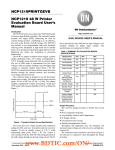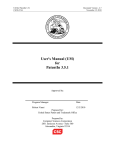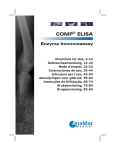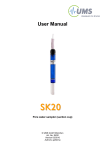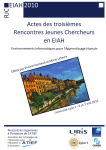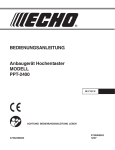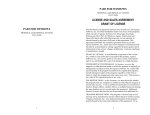Download IFU - DRG International
Transcript
DRG® Cartilage Oligomeric Matrix Protein (Human) (EIA-5265) Revised 1 June 2012 rm (Vers. 2.1) USA: RUO This kit is intended for Research Use Only. Not for use in diagnostic procedures. Please use only the valid version of the package insert provided with the kit. 1 INTENDED USE The Human Cartilage Oligomeric Matrix Protein ELISA is a sandwich enzyme immunoassay for measurement of human cartilage oligomeric matrix protein (COMP). Features The total assay time is less than 3.5 hours The kit measures COMP in serum and plasma (EDTA, citrate, heparin) Assay format is 96 wells Quality Controls are human serum based Standard is recombinant protein based Components of the kit are provided ready to use, concentrated or lyophilized 2 STORAGE, EXPIRATION Store the complete kit at 2-8°C. Under these conditions, the kit is stable until the expiration date (see label on the box). 3 TEST PRINCIPLE In the Human Cartilage Oligomeric Matrix Protein ELISA, standards, quality controls and samples are incubated in microplate wells pre-coated with monoclonal anti-human COMP antibody. After 60 minutes incubation and washing, biotin labelled second monoclonal anti-human COMP antibody is added and incubated with captured COMP for 60 minutes. After another washing, streptavidin-HRP conjugate is added. After 30 minutes incubation and the last washing step, the remaining conjugate is allowed to react with the substrate solution (TMB). The reaction is stopped by addition of acidic solution and absorbance of the resulting yellow product is measured. The absorbance is proportional to the concentration of COMP. A standard curve is constructed by plotting absorbance values against concentrations of standards, and concentrations of unknown samples are determined using this standard curve. 4 PRECAUTIONS For professional use only Wear gloves and laboratory coats when handling kit materials Do not drink, eat or smoke in the areas where kit materials are being handled This kit contains components of human origin. These materials were found non-reactive for HBsAg, HCV antibody and for HIV 1/2 antigen and antibody. However, these materials should be handled as potentially infectious, as no test can guarantee the complete absence of infectious agents This kit contains components of animal origin. These materials should be handled as potentially infectious DRG International, Inc., USA Fax: (908) 233 0758 e-mail: [email protected] 1 DRG® Cartilage Oligomeric Matrix Protein (Human) (EIA-5265) Revised 1 June 2012 rm (Vers. 2.1) USA: RUO Avoid contact with the acidic Stop Solution and Substrate Solution, which contains hydrogen peroxide and tetramethylbenzidine (TMB). Wear gloves and eye and clothing protection when handling these reagents. Stop and/or Substrate Solutions may cause skin/eyes irritation. In case of contact with the Stop Solution and the Substrate Solution wash skin/eyes thoroughly with water and seek medical attention, when necessary The materials must not be pipetted by mouth 5 TECHNICAL HINTS Reagents with different lot numbers should not be mixed Use thoroughly clean glassware Use deionized (distilled) water, stored in clean containers Avoid any contamination among samples and reagents. For this purpose, disposable tips should be used for each sample and reagent Substrate Solution should remain colourless until added to the plate. Keep Substrate Solution protected from light Stop Solution should remain colourless until added to the plate. The colour developed in the wells will turn from blue to yellow immediately after the addition of the Stop Solution. Wells that are green in colour indicate that the Stop Solution has not mixed thoroughly with the Substrate Solution Dispose of consumable materials and unused contents in accordance with applicable national regulatory requirements 6 REAGENT SUPPLIED Kit Components State Quantity Antibody Coated Microtiter Strips ready to use 96 wells Biotin Labelled Antibody ready to use 13 mL Streptavidin-HRP Conjugate ready to use 13 mL Master Standard lyophilized 2 vials Quality Control HIGH lyophilized 2 vials Quality Control LOW lyophilized 2 vials Dilution Buffer ready to use 2 x 13 mL Wash Solution Conc. (10x) concentrated 100 mL Substrate Solution ready to use 13 mL Stop Solution ready to use 13 mL Product Data Sheet + Certificate of Analysis - 1 pc DRG International, Inc., USA Fax: (908) 233 0758 e-mail: [email protected] 2 DRG® Cartilage Oligomeric Matrix Protein (Human) (EIA-5265) Revised 1 June 2012 rm (Vers. 2.1) USA: RUO 7 MATERIAL REQUIRED BUT NOT SUPPLIED Deionized (distilled) water Test tubes for diluting samples Glassware (graduated cylinder and bottle) for Wash Solution (Dilution Buffer) Precision pipettes to deliver 5-1000 µL with disposable tips Multichannel pipette to deliver 100 µL with disposable tips Absorbent material (e.g. paper towels) for blotting the microtitrate plate after washing Vortex mixer Orbital microplate shaker capable of approximately 300 rpm Microplate washer (optional). [Manual washing is possible but not preferable.] Microplate reader with 450 10 nm filter, preferably with reference wavelength 630 nm (alternatively another one from the interval 550-650 nm) Software package facilitating data generation and analysis (optional) 8 PREPARATION OF REAGENTS All reagents need to be brought to room temperature prior to use Always prepare only the appropriate quantity of reagents for your test Do not use components after the expiration date marked on their label Assay reagents supplied ready to use: Antibody Coated Microtiter Strips Stability and storage: Return the unused strips to the provided aluminium zip-sealed bag with desiccant and seal carefully. Remaining Microtiter Strips are stable 3 months when stored at 2 °C - 8 °C and protected from the moisture. Biotin Labelled Antibody Streptavidin-HRP Conjugate Dilution Buffer Substrate Solution Stop Solution Stability and storage: Opened reagents are stable 3 months when stored at 2 °C - 8 °C. Assay reagents supplied concentrated or lyophilized: Human COMP Master Standard DRG International, Inc., USA Fax: (908) 233 0758 e-mail: [email protected] 3 DRG® Cartilage Oligomeric Matrix Protein (Human) (EIA-5265) Revised 1 June 2012 rm (Vers. 2.1) USA: RUO Refer to the Certificate of Analysis for current volume of Dilution Buffer needed for reconstitution of standard!!! Reconstitute the lyophilized Master Standard with Dilution Buffer just prior to the assay. Let it dissolve at least 15 minutes with occasional gentle shaking (not to foam). The resulting concentration of the COMP in the stock solution is 128 ng/mL. Prepare set of standards using Dilution Buffer as follows: Volume of Standard Dilution Buffer Concentration Stock - 128 ng/mL 300 µL of stock 300 µL 64 ng/mL 300 µL of 64 ng/mL 300 µL 32 ng/mL 300 µL of 32 ng/mL 300 µL 16 ng/mL 300 µL of 16 ng/mL 300 µL 8 ng/mL 300 µL of 8 ng/mL 300 µL 4 ng/mL Prepared Standards are ready to use, do not dilute them. Stability and storage: Do not store the Standard stock solution and set of standards. Quality Controls HIGH, LOW Refer to the Certificate of Analysis for current volume of Dilution Buffer needed for reconstitution and for current Quality Control concentration!!! Reconstitute each Quality Control (HIGH and LOW) with Dilution Buffer just prior to the assay. Let it dissolve at least 15 minutes with occasional gentle shaking (not to foam). Reconstituted Quality Controls are ready to use, do not dilute them. Stability and storage: The reconstituted Quality Controls must be used immediately or stored frozen at -20 °C for 1 month. Avoid repeated freeze/thaw cycles. Note: Concentration of analyte in Quality Controls need not be anyhow associated with normal and/or pathological concentrations in serum or another body fluid. Quality Controls serve just for control that the kit works in accordance with the user’s manual and Certificate of Analysis and that ELISA test was carried out properly. Wash Solution Conc. (10x) Dilute Wash Solution Concentrate (10x) ten-fold in distilled water to prepare a 1x working solution. Example: 100 mL of Wash Solution Concentrate (10x) + 900 mL of distilled water for use of all 96-wells. Stability and storage: The diluted Wash Solution is stable 1 month when stored at 2 °C - 8 °C. Opened Wash Solution Concentrate (10x) is stable 3 months when stored at 2 °C - 8 °C. DRG International, Inc., USA Fax: (908) 233 0758 e-mail: [email protected] 4 DRG® Cartilage Oligomeric Matrix Protein (Human) (EIA-5265) Revised 1 June 2012 rm (Vers. 2.1) USA: RUO 9 PREPARATION OF SAMPLES The kit measures human COMP in serum and plasma (EDTA, citrate, heparin). Samples should be assayed immediately after collection or should be stored at -20 °C. Mix thoroughly thawed samples just prior to the assay and avoid repeated freeze/thaw cycles, which may cause erroneous results. Avoid using hemolyzed or lipemic samples. Dilute samples 50x with Dilution Buffer just prior to the assay (e.g. 5 µL of sample + 245 µL of Dilution Buffer for singlets or duplicates). Mix well (not to foam). Vortex is recommended. Stability and storage: Samples should be stored at -20°C, or preferably at -70°C for long-term storage. Avoid repeated freeze/thaw cycles. Do not store the diluted samples. See Chapter 13 for stability of serum and plasma samples when stored at 2 °C - 8 °C, effect of freezing/thawing and effect of sample matrix (serum/plasma) on the concentration of human COMP. Note: It is recommended to use a precision pipette and a careful technique to perform the dilution in order to get precise results. 10 ASSAY PROCEDURE Pipet 100 µL of Standards, Quality Controls, Dilution Buffer (=Blank) and samples, preferably in duplicates, into the appropriate wells. See Figure 1 for example of work sheet. 1. 2. Incubate the plate at room temperature (ca. 25 °C) for 1 hour, shaking at ca. 300 rpm on an orbital microplate shaker. 3. Wash the wells 3-times with Wash Solution (0.35 mL per well). After final wash, invert and tap the plate strongly against paper towel. 4. Add 100 µL of Biotin Labelled Antibody into each well. 5. Incubate the plate at room temperature (ca. 25 °C) for 1 hour, shaking at ca. 300 rpm on an orbital microplate shaker. 6. Wash the wells 3-times with Wash Solution (0.35 mL per well). After final wash, invert and tap the plate strongly against paper towel. 7. Add 100 µL of Streptavidin-HRP Conjugate into each well. 8. Incubate the plate at room temperature (ca. 25 °C) for 30 minutes, shaking at ca. 300 rpm on an orbital microplate shaker. 9. Wash the wells 3-times with Wash Solution (0.35 mL per well). After final wash, invert and tap the plate strongly against paper towel. 10. Add 100 µL of Substrate Solution into each well. Avoid exposing the microtiter plate to direct sunlight. Covering the plate with e.g. aluminium foil is recommended. DRG International, Inc., USA Fax: (908) 233 0758 e-mail: [email protected] 5 DRG® Cartilage Oligomeric Matrix Protein (Human) (EIA-5265) Revised 1 June 2012 rm (Vers. 2.1) USA: RUO 11. Incubate the plate for 10 minutes at room temperature. The incubation time may be extended [up to 20 minutes] if the reaction temperature is below than 20 °C. Do not shake the plate during the incubation. 12. Stop the colour development by adding 100 µL of Stop Solution. 13. Determine the absorbance of each well using a microplate reader set to 450 nm, preferably with the reference wavelength set to 630 nm (acceptable range: 550 – 650 nm). Subtract readings at 630 nm (550 - 650 nm) from the readings at 450 nm. The absorbance should be read within 5 minutes following step 12. Note: If some samples and standard/s have absorbances above the upper limit of your microplate reader, perform a second reading at 405 nm. A new standard curve, constructed using the values measured at 405 nm, is used to determine COMP concentration of off-scale standards and samples. The readings at 405 nm should not replace the readings for samples that were “in range” at 450 nm. Note 2: Manual washing: Aspirate wells and pipet 0.35 mL Wash Solution into each well. Aspirate wells and repeat twice. After final wash, invert and tap the plate strongly against paper towel. Make certain that Wash Solution has been removed entirely. strip 1+2 strip 3+4 strip 5+6 strip 7+8 strip 9+10 strip 11+12 A Standard 128 Blank Sample 8 Sample 16 Sample 24 Sample 32 B Standard 64 Sample 1 Sample 9 Sample 17 Sample 25 Sample 33 C Standard 32 Sample 2 Sample 10 Sample 18 Sample 26 Sample 34 D Standard 16 Sample 3 Sample 11 Sample 19 Sample 27 Sample 35 E Standard 8 Sample 4 Sample 12 Sample 20 Sample 28 Sample 36 F Standard 4 Sample 5 Sample 13 Sample 21 Sample 29 Sample 37 G QC HIGH Sample 6 Sample 14 Sample 22 Sample 30 Sample 38 H QC LOW Sample 7 Sample 15 Sample 23 Sample 31 Sample 39 DRG International, Inc., USA Fax: (908) 233 0758 e-mail: [email protected] Figure 1: Example of a work sheet. 6 DRG® Cartilage Oligomeric Matrix Protein (Human) (EIA-5265) Revised 1 June 2012 rm (Vers. 2.1) USA: RUO 11 CALCULATIONS Most microplate readers perform automatic calculations of analyte concentration. The standard curve is constructed by plotting the mean absorbance (Y) of Standards against the known concentration (X) of Standards in logarithmic scale, using the four-parameter algorithm. Results are reported as concentration of COMP ng/mL in samples. Alternatively, the logit log function can be used to linearize the standard curve, i.e. logit of the mean absorbance (Y) is plotted against log of the known concentration (X) of Standards. The measured concentration of samples calculated from the standard curve must be multiplied by their respective dilution factor, because samples have been diluted prior to the assay, e.g. 20 ng/mL (from standard curve) x 50 (dilution factor) = 1 000 ng/mL. Human Cartilage Oligomeric Matrix Protein ELISA - Standard Curve 3.5 Absorbance (A450 nm-A630 nm) 3.0 2.5 2.0 1.5 1.0 0.5 0.0 1 10 100 1000 Concentration of Hu COMP (ng/ml) Figure 2: Typical Standard Curve for Human Cartilage Oligomeric Matrix Protein ELISA. DRG International, Inc., USA Fax: (908) 233 0758 e-mail: [email protected] 7 DRG® Cartilage Oligomeric Matrix Protein (Human) (EIA-5265) Revised 1 June 2012 rm (Vers. 2.1) USA: RUO 12 STABILITY OF SAMPLES STORED AT 2 °C - 8 °C Samples should be stored at –20 °C. However, no decline in concentration of COMP was observed in serum and plasma samples after 7 days when stored at 2 °C - 8 °C. To avoid microbial contamination, samples were treated with aminocaproic acid and sodium azide, resulting in the final concentration of 0.03% and 0.1%, respectively. Plasma (ng/mL) Sample 1 2 3 Incubation Temp, Period Serum (ng/mL) EDTA Citrate Heparin -20 °C 443 328 352 488 2 °C - 8 °C, 1 day 481 302 355 499 2 °C - 8 °C, 7 days 482 264 345 374 -20 °C 985 674 711 910 2 °C - 8 °C, 1 day 993 631 728 837 2 °C - 8 °C, 7 days 1 024 601 771 1 036 -20 °C 847 491 629 713 2 °C - 8 °C, 1 day 866 515 654 793 2 °C - 8 °C, 7 days 905 493 605 853 DRG International, Inc., USA Fax: (908) 233 0758 e-mail: [email protected] 8 DRG® Cartilage Oligomeric Matrix Protein (Human) (EIA-5265) Revised 1 June 2012 rm (Vers. 2.1) USA: RUO 12.1 Effect of Freezing/Thawing No decline was observed in concentration of human COMP in serum and plasma samples after repeated (5x) freeze/thaw cycles. However it is recommended to avoid unnecessary repeated freezing/thawing of the samples. Sample 1 2 3 Number of f/t cycles Serum (ng/mL) Plasma (ng/mL) EDTA Citrate Heparin 1x 1 105 632 820 1 121 3x 1 040 610 783 914 5x 1 010 559 727 867 1x 942 702 733 921 3x 893 665 707 764 5x 894 716 614 728 1x 1 224 884 1 133 1 100 3x 1 275 843 975 1 182 5x 1 220 856 873 1 080 13 DEFINITION OF THE STANDARD The recombinant human COMP is used as the Standard. The recombinant human COMP is produced in cell line HEK293. 13.1 Reference range The data quoted in these instructions should be used for guidance only. It is recommended that each laboratory include its own panel of control sample in the assay. Each laboratory should establish its own normal and pathological references ranges for COMP levels with the assay. DRG International, Inc., USA Fax: (908) 233 0758 e-mail: [email protected] 9 DRG® Cartilage Oligomeric Matrix Protein (Human) (EIA-5265) Revised 1 June 2012 rm (Vers. 2.1) USA: RUO 14 TROUBLESHOOTING AND FAQS Weak signal in all wells Possible explanations: Omission of a reagent or a step Improper preparation or storage of a reagent Assay performed before reagents were allowed to come to room temperature Improper wavelength when reading absorbance High signal and background in all wells Possible explanations: Improper or inadequate washing Overdeveloping; incubation time with Substrate Solution should be decreased before addition of Stop Solution Incubation temperature over 30 °C High coefficient of variation (CV) Possible explanation: Improper or inadequate washing Improper mixing Standards, Quality Controls or samples 15 REFERENCES V. Vilim, M.E. Lenz, R. Vytasek, K. Masuda, K. Pavelka, K.E. Kuettner and E. J-M. Thonar: Characterization of monoclonal antibodies recognizing different fragments of cartilage oligomeric matrix protein in human body fluid. Arch Biochem Biophys 341, 8-16 (1997) V. Vilim, R. Vytasek, M. Olejarova, S. Machacek, J. Gatterova, B. Prochazka, V. B. Kraus and K. Kavala: Serum cartilage oligimeric matrix protein reflects the presence of clinically diagnosed synovitis in patients with knee osteoarthritis. Osteoarthritis and Cartilage 9, 612-618 (2001) K. Misumi, V. Vilim, P.D. legg, C. C. M. Thompson and S. D. Carter: Measurement of cartilage oligomeric matrix protein (COMP) in normal and diseased equine synovial fluids. Osteoarthritis and Cartilage 9, 119-127 (2001) V. Vilim. M. Olejarova, S. Machacek, J. Gatterova, V.B. Kraus, K. Pavelka: Serum levels of cartilage oligomeric matrix protein (COMP) correlate with radiographic progression of knee osteoarthritis. Osteoarthr Cart 10, 707-713 (2002) A.D. Dragomir, V.B. Kraus, J.B. Rennef, G. Luta, A. Clark, V. Vilim, M.C. Hochberg, C.G. Helmick and J.M. Jordan: Serum cartilage oligomeric matrix protein and clinical signs and symptoms of potential pre-radiographic hip and knee pathology. Osteoarthritis and Cartilage 10, 687-691 (2002) DRG International, Inc., USA Fax: (908) 233 0758 e-mail: [email protected] 10 DRG® Cartilage Oligomeric Matrix Protein (Human) (EIA-5265) Revised 1 June 2012 rm (Vers. 2.1) USA: RUO V. Vilim, Z. Voburka, R. Vytasek, L. Senolt, I. Tchetverikov, V. B. Kraus and K. Pavelka: Monoclonal antibodies to human cartilage oligomeric matrix protein: epitope mapping and characterization of sandwich ELISA. Clinica Chimica Acta 328, 59-69 (2003) O. Bruzere, J. H. Collette, O. Ethgen, L. C. Rovati, G. Giacovelli, Y. E. Henrotin, L. Seidel and J-Y. L. Reginster: Biochemical Markers of bone and Cartilage remodelling in prediction of longterm progression of knee osteoarthritis. The Journal of Rheumatilogy 30, 1043-1050 (2003) J. M. Jordan, G. Luta, T. Stabler, J. B. Renner, A. D. Dragomir, V. Vilim, M. C. Hochberg, C. G. Helmick and V. B. Kraus: Ethnic and sex differences in serum levels of cartilage oligomeric matrix protein. Arthritis Rheumatism 3, 675-681 (2003) M. Skoumal, G. Haberhauer, J. Feyertag, E.M. Kittl, K. Bauer and A. Dunky: Serum levels of cartilage oligomeric matrix protein are elevated in rheumatoid arthritis, but not in inflammatory rheumatic diseases such as psoriatic arthritis, Raynaund´s syndrome, scleroderma, systemic lupus erythematosus, vasculitis and Sjögren´s syndrome. Arthritis Res Ther 6, 73-74 (2004) V. Chandran, R.J. Cook, J. E.dwin, H. Shen, F.J. Pellett, S. Shanmugarajah, C.F. Rosen and D. D. Gladman: Soluble biomarkers differentiate patients with psoriatic arthritis from those psoriasis without arthrithis. Rheumatology 49, 1399–1405 (2010) DRG International, Inc., USA Fax: (908) 233 0758 e-mail: [email protected] 11 DRG® Cartilage Oligomeric Matrix Protein (Human) (EIA-5265) Revised 1 June 2012 rm (Vers. 2.1) USA: RUO 16 ASSAY PROCEDURE SUMMARY DRG International, Inc., USA Fax: (908) 233 0758 e-mail: [email protected] 12 DRG® Cartilage Oligomeric Matrix Protein (Human) (EIA-5265) Revised 1 June 2012 rm (Vers. 2.1) USA: RUO Rev. 5/31/12cc DRG International, Inc., USA Fax: (908) 233 0758 e-mail: [email protected] 13
















